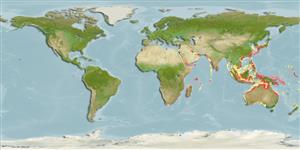>
Eupercaria/misc (Various families in series Eupercaria) >
Haemulidae (Grunts) > Plectorhinchinae
Etymology: Plectorhinchus: Greek, plektos = plaited + Greek, rhyngchos = snout (Ref. 45335).
More on author: Regan.
Environment: milieu / climate zone / depth range / distribution range
Écologie
marin récifal. Tropical
Indo-West Pacific: Somalia (Ref. 30573) and Kenya and India to Port Alfred, South Africa. Reported from Indonesia (Ref. 5978).
Taille / Poids / Âge
Maturity: Lm ? range ? - ? cm
Max length : 75.0 cm TL mâle / non sexé; (Ref. 2799); poids max. publié: 5.0 kg (Ref. 9710)
Description synthétique
Clés d'identification | Morphologie | Morphométrie
Épines dorsales (Total) : 11 - 12; Rayons mous dorsaux (Total) : 16 - 17; Épines anales: 3; Rayons mous anaux: 7 - 8. Adults bronze with small white spots, lips pink; young dusky olive to greyish (Ref. 2799).
A relatively rare species (Ref. 9710) found in coastal areas near reefs (Ref. 30573). Juveniles in shallow weedy areas. Omnivorous (Ref. 2799). Good to eat.
Life cycle and mating behavior
Maturities | Reproduction | Spawnings | Egg(s) | Fecundities | Larves
Oviparous, distinct pairing during breeding (Ref. 205).
Smith, M.M. and R.J. McKay, 1986. Haemulidae. p. 564-571. In M.M. Smith and P.C. Heemstra (eds.) Smiths' sea fishes. Springer-Verlag, Berlin. (Ref. 2799)
Statut dans la liste rouge de l'IUCN (Ref. 130435)
Menace pour l'homme
Harmless
Utilisations par l'homme
Pêcheries: commercial; pêche sportive: oui
Outils
Articles particuliers
Télécharger en XML
Sources Internet
Estimates based on models
Preferred temperature (Ref.
123201): 18.7 - 29, mean 27.7 °C (based on 830 cells).
Phylogenetic diversity index (Ref.
82804): PD
50 = 0.5000 [Uniqueness, from 0.5 = low to 2.0 = high].
Bayesian length-weight: a=0.01950 (0.00846 - 0.04494), b=2.95 (2.75 - 3.15), in cm total length, based on LWR estimates for this (Sub)family-body shape (Ref.
93245).
Niveau trophique (Ref.
69278): 3.8 ±0.6 se; based on size and trophs of closest relatives
Résilience (Ref.
120179): Faible, temps minimum de doublement de population : 4,5 à 14 années (Preliminary K or Fecundity.).
Fishing Vulnerability (Ref.
59153): Moderate to high vulnerability (50 of 100).
Nutrients (Ref.
124155): Calcium = 22.2 [10.8, 45.0] mg/100g; Iron = 0.461 [0.239, 0.830] mg/100g; Protein = 18.9 [17.0, 20.9] %; Omega3 = 0.093 [0.046, 0.167] g/100g; Selenium = 40.6 [22.2, 73.9] μg/100g; VitaminA = 42.1 [12.6, 138.0] μg/100g; Zinc = 0.839 [0.552, 1.265] mg/100g (wet weight);
